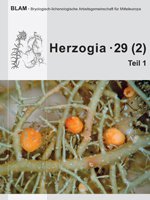Magain, N., Sérusiaux, E., Zhurbenko, M. P., Lutzoni, F. & Miadlikowska, J. 2016. Disentangling the Peltigera polydactylon species complex by recognizing two new taxa, P. polydactylon subsp. udeghe and P. seneca. — Herzogia 29: 514–528.
A new species, Peltigera seneca, and two subspecies within P. polydactylon (s.str.), P. polydactylon subsp. udeghe and P. polydactylon subsp. polydactylon, were segregated from a broadly defined P. polydactylon s.lat., based mostly on molecular data and distinct geographical ranges. Peltigera polydactylon s.str. and P. seneca form well-supported monophyletic lineages that share a most recent common ancestor and were recognized as two distinct species by multiple species delimitation and validation methods. Peltigera polydactylon s. str. has a broad intercontinental distribution whereas the new species P. seneca is restricted to eastern North America where it seems to be rare. Peltigera polydactylon subsp. udeghe and P. polydactylon subsp. polydactylon, were defined to accommodate two monophyletic and strongly supported clades separated geographically (North America, eastern Northern Asia and Australasia versus Europe, Middle East and central Northern Asia, respectively). Despite the low genetic distance, especially for the ITS, between these two subspecies, they are well segregated genetically throughout their allopatric ranges. However, there seems to be an intermediary pattern of variation in the geographical area where both taxa are likely to co-occur (e.g., central and eastern Northern Asia). Phenotypic traits have limited value in distinguishing these three taxa. They are chemically (secondary metabolites) similar and share the same Nostoc (cyanobiont) phylogroup. Nevertheless, there are helpful phenotypic trends in addition to their diagnostic genotypes.





